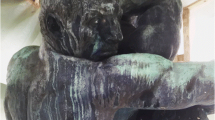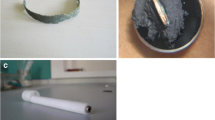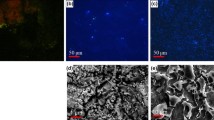Abstract
In the literature, the ability to transform metal compounds into metal oxalates has been reported for different species of fungi. This could be an innovative conservation method for archaeological and artistic metal artefacts. In fact, with a high degree of insolubility and chemical stability even in acid atmospheres (pH 3), metal oxalates provide the surface with good protection. Within the framework of the EU-ARTECH project, different fungal strains have been used to transform existing corrosion patinas on outdoor bronze monuments into copper oxalates, while preserving the physical appearance of these artefacts. Given the promising results obtained with this first attempt, the same approach is now applied within the BAHAMAS (Marie Curie Intra European Fellowship action) project, but extended to other metal substrates, for example iron and silver, which are frequently found in cultural heritage artworks and also encounter several problems of active corrosion. The research is investigating the formation mechanisms and adhesion properties of the newly formed metal oxalates by means of complementary analytical techniques (X-ray diffraction (XRD), FTIR microscopy, Raman microscopy, scanning electron microscopy (SEM-EDS), electrochemical impedance spectroscopy (EIS), colorimetry). For each metal substrate, the most appropriate fungal strain is going to be identified and applied to corroded sheets and the novel fungal treatment compared with those used so far. Treated metal sheets will be monitored during 1-year exposure to different cycles of artificial ageing, to evaluate the corrosion resistance of the fungal patinas obtained. The objective of this contribution is to present the first results achieved so far on naturally corroded bronze sheets during the EU-ARTECH project and the analytical procedure used for the testing of the proposed treatment performances during the BAHAMAS project.








Similar content being viewed by others
References
Brandi C (2005) Theory of restoration. Nardini Editore, Florence
Letardi P (2004) In: Ashton J, Hallam D (eds) Proceedings of metal 2004. National Museum of Australia, Canberra
Brostoff LB (2003) Coating strategies for the protection of outdoor bronze art and ornamentation. Ph.D. dissertation, Universiteit van Amsterdam
Marabelli M, Napolitano G (1991) Materiali e strutture 1:51–58
Moffett DL (1996) J Am Inst Conserv 35:1–8
Johnson R (1984) In: Brommelle NS, Pye EM, Smith P, Thomson G (eds) Adhesives and consolidants. International Institute for Conservation of Historical and Artistic Works (IIC), London
Sayer JA, Kierans M, Gadd GM (1997) FEMS Microbiol Lett 154:29–35
Gharieb MM, Ali MI, El-Shoura AA (2004) Biodegrad 15:49–57
Tabak HH et al (2005) Rev Environ Sci Biotechnol 4:115–156
Godlewska-Żyłkiewicz B (2006) Anal Bioanal Chem 384:114–123
Nassau K, Gallagher PK, Miller AE, Graedel TE (1987) Corros Sci 27:69–84.2
Marabelli M, Mazzeo R (1993) La metallurgia italiana 85:247–254
Bharde A, Rautaray D, Bansal V, Ahmad A, Sarkar I, Yusuf SM, Sanyal M, Sastry M (2006) Small 2:135–141
Castanier S, Le Métayer-Levrel G, Orial G, Loubière J-F, Perthuisot J-P (2000) In: Ciferri O, Tiano P, Mastromei G (eds) Of microbes and art. Plenum, New York
Zuo R (2007) Appl Microbiol Biotechnol 76:1245–1253
Graedel TE (1987) Corros Sci 27:721–740
Krätschmer A, Odnewall Wallinder I, Leygraf C (2002) Corros Sci 44:425–450
Mazzeo R (2005) In: Tiano P, Pardini C (eds) Le patine: genesi significato e conservazione. Kermesquaderni. Nardini Editore, Florence
Längle T (2006) In: Proceedings of the REBECA (Regulation Of Biological Control Agents) workshop on current risk assessment and regulation practice, Schloss Salzau (Kiel) Germany. http://www.rebeca-net.de/downloads/Beauveria%20bassiana.pdf, accessed September 9, 2010
Gadd GM (1993) New Phytol 124:25–60
Gadd GM (2007) Mycol Res 111:3–49
Cameselle C, Bohlmann JT, Nuñez MJ, Lena JM (1998) Bioprocess Eng 19:247–252
Santoro R, Cameselle C, Rodríguez-Couto S, Sanromán Á (1999) Bioprocess Eng 20:1–5
Rymowicz W, Lenard D (2003) Biotechnol Lett 25:955–958
Sayer JA, Gadd GM (1997) Mycol Res 101:653–661
Acknowledgments
This research was partially carried out with the support of the European Union, within the VI Framework Programme (Contract: Eu-ARTECH, RII3-CT-2004-506171, 2004-2009) and within the VII Framework Programme (Contract: BAHAMAS, PIEF-GA-2009-252759, 2010-2012). The authors also acknowledge Mr T. Adatte (Institute of Geology and Palaeontology, University of Lausanne, Switzerland) for providing X ray diffraction facilities and would like to thank him for assistance during experiments at the Geological Institute of the University of Neuchâtel, Switzerland. The authors are also grateful to Mr M. Dadras for his assistance during ESEM experiments at the Centre Suisse d’Electronique et Microtechnique SA, Neuchâtel, Switzerland.
Author information
Authors and Affiliations
Corresponding author
Additional information
Published in the special issue Analytical Chemistry for Cultural Heritage with Guest Editors Rocco Mazzeo, Silvia Prati, and Aldo Roda.
Rights and permissions
About this article
Cite this article
Joseph, E., Simon, A., Prati, S. et al. Development of an analytical procedure for evaluation of the protective behaviour of innovative fungal patinas on archaeological and artistic metal artefacts. Anal Bioanal Chem 399, 2899–2907 (2011). https://doi.org/10.1007/s00216-010-4279-2
Received:
Revised:
Accepted:
Published:
Issue Date:
DOI: https://doi.org/10.1007/s00216-010-4279-2




